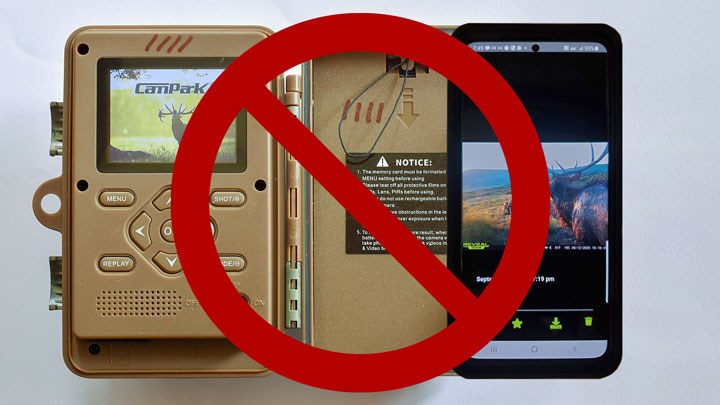
by Mark Chesnut - Thursday, January 13, 2022

We told you last summer about Arizona wildlife officials banning the use of trail cameras “for the purpose of taking or aiding in the take of wildlife or locating wildlife for the purpose of taking or aiding in the take of wildlife”—in other words, the very job they were designed to perform. Back in 2018, the Arizona Game and Fish Department Commission had banned the use of live-action trail cameras, which allowed hunters to monitor their cameras without physically visiting them, but the new ban made Arizona the first state with a year-round ban on the popular scouting devices.
Now Utah has followed suit with a recent decision that has many crying foul. At its meeting on Jan. 3, the Utah Wildlife Board, which makes rule-change recommendations to the state’s Division of Wildlife Resources, voted 4-3 to ban the use of trail cameras and some other electronics in hunting through most of the big game hunt season.
“We did slow down on this process,” Kevin Albrecht, chairman of the Utah Wildlife Board, told news station ksl.com prior to the final vote. Incidentally, Albrecht cast the tie-breaking vote to approve the move. “We wanted additional surveys to make sure that we really (had) a pulse on the public.”
According to the new ruling, beginning in 2022 hunters won’t be allowed to use handheld or non-handheld transmitting and non-transmitting devices between July 31 and Dec. 31. The state defines a trail camera as “a device that is not held or manually operated by a person and is used to capture images, video or location data of wildlife and uses heat or motion to trigger the device.”
In addition, the board took a swipe at manufacturers that produce and hunters who use ultra-popular night-vision devices that are now available to consumers at far more reasonable prices compared to a decade ago. The rule bans use of such night-vision devices to locate or try to locate any big-game animals beginning 48 hours before any big-game hunt opening date and remaining in place until 48 hours after that big-game hunt ends. The board defines a night-vision device as any “device that aids in finding animals during the night, including thermal imaging devices.”
A few exceptions were made to the new rule, including allowing trail cameras for the non-hunting monitoring of property. Farmers and ranchers also are permitted to use transmitting cameras even during hunting seasons to aid in removing predators that might kill their valuable livestock.
One Utah legislator, Rep. Mike Schulz, voiced his approval of the ban.
“It's not a fair hunt any longer,” Schultz said. “So, we have a responsibility ourselves, as sportsmen that care about the wildlife, to make sure we're being ethical in the things that we do.”
As we mentioned following the Arizona ban, that is strong talk, considering the millions of ethical hunters throughout the country who use cameras and enjoy setting them out and reviewing the photos and video footage they capture.
Note that Utah and Arizona aren’t the only states to ban the use of such devices for hunting purposes. In 2018, Nevada instituted a law stating that a person shall not place, maintain or use a trail camera or similar device on public land, or private land without permission from the landowner, from Aug. 1 to Dec. 31 of each year. If the camera has the capability of transmitting the images or video, it shall not be used from July 1 to Dec. 31. The Nevada law also prohibits the use of trail cameras at any time if the placement, maintenance or use of the trail camera or similar device prevents wildlife from accessing, or alters the manner in which wildlife accesses, a spring, water source or artificial basin that is used by wildlife and collects or is designed and constructed to collect water.
Additionally, Montana banned the use of all trail cameras in 2010, but the law was later changed to apply only to those that are linked to cell phones and that transmit pictures and videos remotely. Meanwhile, in New Hampshire, a difficult-to-enforce law prohibits hunters from taking an animal on the same day that trail camera images of that animal are captured. And in Alaska, wildlife officials restrict the amount of information hunters are permitted to receive from trail cameras during the hunting season.
About the Author
Freelance writer and editor Mark Chesnut is the owner/editorial director at Red Setter Communications LLC in Jenks, Okla. An avid hunter, shooter and field-trialer, he has been covering Second Amendment issues and politics on a near-daily basis for over 20 years.
E-mail your comments/questions about this site to:
[email protected]
